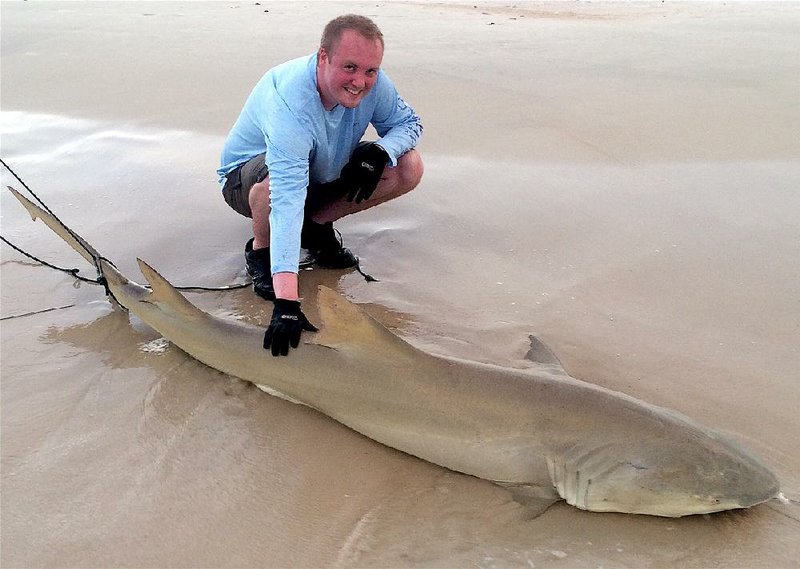Charles Harger of Maumelle flopped on his back to keep from being dragged into the sea.
It happened during one of his annual shark fishing trips to Florida with his brother Hal Harger of Little Rock. At night, in pitch darkness, amid the pounding of the surf.
An immense shark hit Charles's bait hard and tore away so fast that line burned off his giant reel. That's not unusual, and it's manageable if you've set the drag on your reel properly. Tighten it gradually and let your tackle tame the leviathan.
If the drag is set too tight, as it was in that instance, then it's the shark's brute strength against the angler's relative lack thereof.
The shark jerked Charles forward toward the surf. He tried to dig his heels into the sand and left skid marks. His last resort was to fall backwards and anchor to the beach. The line snapped at the hook, and the battle ended almost as quickly as it began.
Hal Harger of Little Rock, Charle's brother, said it wasn't the first time.
"We never get mad," Hal Harger said. "We take our hats off to the fish. We realize there are some things out there that are too big for us to handle."
Sharks have a peerless mystique among those that admire the sea. Sleek and tireless - with highly acute senses of sight, smell, touch and electroreception - sharks are highly specialized predators that rank second only to orcas in the marine food chain.
They're fearsome and awesome, the ultimate in cool.
Some 45 species of sharks inhabit the world's oceans. Many, including the bull shark, hammerhead, lemon, blacktip, bonnethead and Atlantic sharpnose, inhabit the Gulf of Mexico and the Atlantic Ocean along the Florida coast. Tiger sharks arrive in the fall, Hal Harger said.
"The hammerhead is a very fast shark," Hal Harger said. "The lemon shark is not as fast. The bull shark is slow and powerful. We respect them and learn as much about them as we can."
The Hargers release every shark they catch, and they use heavy tackle to subdue their quarry quickly to reduce stress. They fish only from beaches, but they never fish around other beachgoers. That means finding uninhabited beaches or fishing at night.
"Every shark I have landed has been after dark," Hal said. "Visually it's more exciting in the day, but I have better luck at night. We don't want to upset swimmers. We don't want to give shark fishing a bad name in any way."
To further reduce stress on the sharks they land, the Hargers snip barbs from their hooks with wire cutters and remove them without injuring the shark's mouth. They also use freshwater grade hooks because they'll rust away faster than saltwater hooks if a shark breaks the line.
If you fish for big catfish in Arkansas, you already know the basics of shark fishing in the surf, Hal said. The equipment is bigger, but the techniques are similar.
The Harger's shark tackle includes 12-foot Sea Striker rods.
"The longer the rod, the farther longer you can throw," Hal Harger said. "There's two feet of line from the tip of the rod to the bait. You need heavy enough rods to get them out."
The Hargers use a combination of conventional saltwater reels and spinning reels. Charles Harger said his preferred spinning reel is a Penn Spinfisher 10500, the largest spinning reel made. They also use the Penn Battle 8000, a smaller reel that can handling sharks up to about 6 feet long.
Of course, a shark doesn't know or care which reel it challenges.
"No,it doesn't," Charles Harger said. "When we started out, we were catching four-and-a-half to five-and-a-half foot sharks, and the Penn Battle 8000 worked great for them. If we'd known up front what we know now, the 10500 would have been the only reel we ever bought."
Sometimes, even that isn't enough.
"I had a shark blow up a reel one night," Charles said. "It bent the main axle and just blew whole side of that 10500 reel out. That was a huge shark, probably a hammerhead. They're super fast."
The Hargers back their 10500 spinning reels with a 80- to 105-pound PowerPro or Spider Wire Stealth. For the 8000 series Penn Battles they use 65-pound braid.
They top them with as much 50-pound test Berkley Big Game monofilament line as possible. Fifty-pound test Big Game is actually good up to about 67 pounds, Charles said. It also resists abrasion better than braid, which breaks easily when dragged across sandbars.
They use Albright knots to join braid to mono.
At the terminal end of the mono is a three-way swivel. The Hargers clip a 4-ounce pyramid weight directly to one loop on the swivel.
On the other loop is 30-35 feet of coated Titanium weed whacker cable.
"It's got a grip-like surface," Charles said. "When you grab the cable to pull shark in by hand, it gives you some traction.
"Don't wrap it around your hand," he added, "because you'll be gone if that shark makes another run."
Attached to the weed whacker cable is a five-foot length of 900-pound, 7x7 stainless steel cable.
"Sharks don't bite through that 900 pounds at all," Hal Harger said. "They'll bite through 600-pound, and they'll cut it with their tails, dorsal fins and pectoral fins, too."
The Hargers cast the spinning reels from the beach. To get farther out, they also use big conventional saltwater trolling reels. Charles said his favorite is the FinNor ST-50. They use only monofilament on the conventional rigs and 20/0 Mustad circle hooks. They use kayaks to paddle up to about 400 yards offshore where they drop their baits over the deep side of the last sandbar.
For bait they use frozen menhaden, mullet heads or stingrays.
They deploy about seven rods in all. Charles Harger hammers long sections of PVC about 2 1/2 feet into the sand to serve as rod holders. They also clip lights to the ends of their rods, which they cover with red balloons, Hal Harger said, to avoid attracting sea turtles onto the beach.
A dancing light signals a shark on the line, and if a shark pulls a rod into the water, the light enables you to run down the rod and recover it.
When the rod man gets the shark close enough to see the cable, an assistant grabs the leader and hauls the shark to shore. That entails wading out in water that can be waist-deep to chest-deep, and that's a hard mental barrier for newbies, Charles Harger said, laughing.
"At first it was hilarious," Charles said, "but that shark is trying to get away. It's not going to turn on you."
The best time to fish for sharks from the beach is in June and July, with July being better for hammerheads, Hal said.
Sports on 07/15/2018


